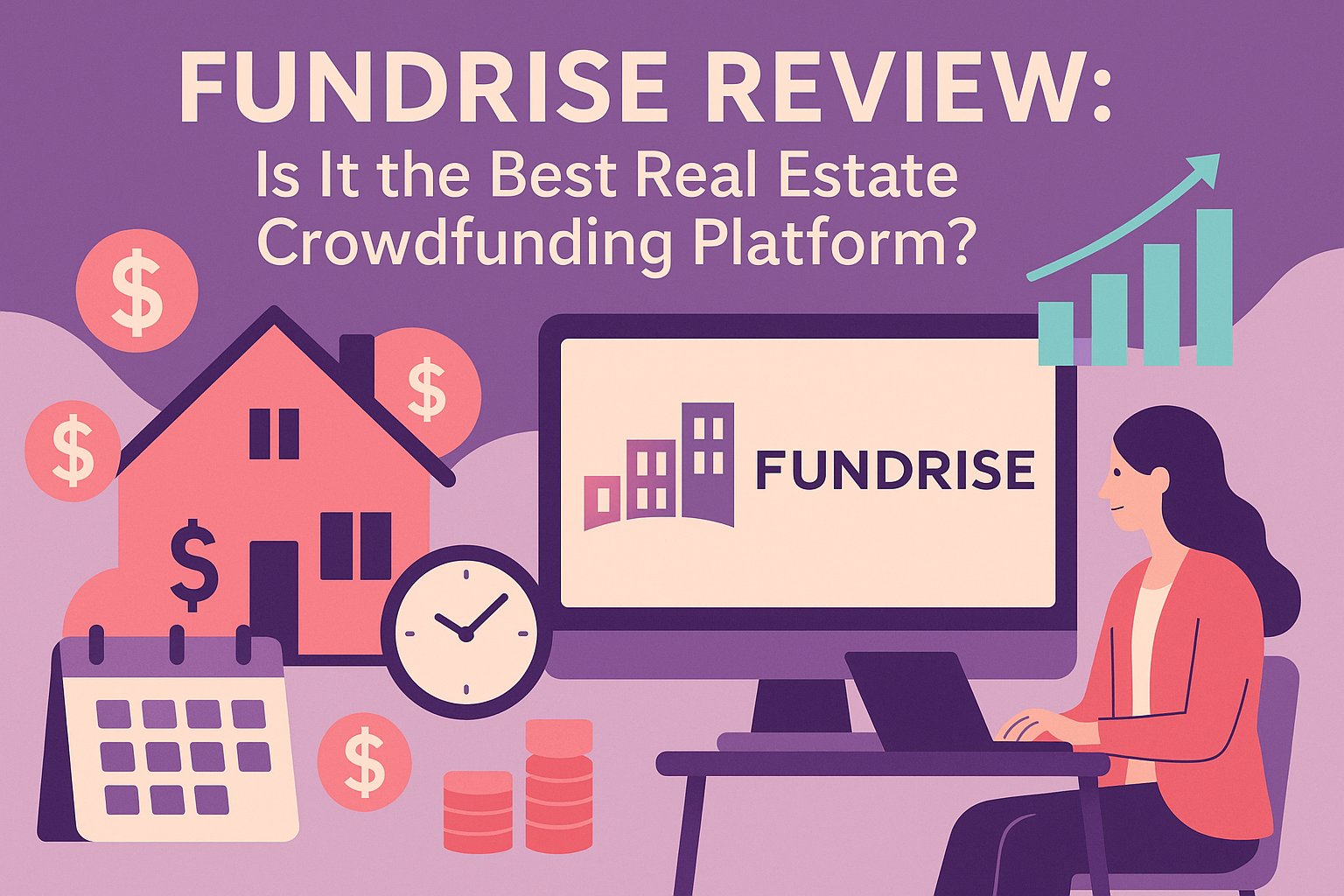Navigating the World of Real Estate Crowdfunding
In the ever-evolving landscape of real estate investing, crowdfunding platforms have democratized access for those who once felt locked out of brick-and-mortar acquisitions. Among the leading names in this space, Fundrise stands out as a pioneer that blends technology with traditional real estate fundamentals. But is Fundrise truly the best real estate crowdfunding platform for passive investors? In this review, we’ll dive deep into its structure, performance, fees, user experience, and overall value proposition, helping you determine if Fundrise aligns with your financial goals and risk tolerance.
Unveiling Fundrise: A Brief Overview
Founded in 2010, Fundrise set out to transform the way individuals invest in real estate by creating a user-friendly, online marketplace that aggregates capital to acquire income-producing properties. Rather than requiring a six-figure down payment for a single asset, Fundrise enables investors to pool their resources into diversified portfolios, known as eREITs and eFunds. These offerings include a mix of residential, commercial, and mixed-use developments across major markets. Underneath the hood, the company operates its own sponsor teams, sourcing properties directly or partnering with experienced developers. By removing intermediaries and streamlining the process, Fundrise has attracted over a million users and managed billions in assets, cementing its reputation as a leader in the crowdfunding arena.
Exploring Unique Investment Vehicles
At the heart of Fundrise’s value proposition are its proprietary eREITs and eFunds. Unlike standard publicly traded REITs that focus on broad property classes, Fundrise’s eREITs are subdivided by strategy: Starter, Supplemental Income, Balanced Income, and Long-Term Growth. The Starter Portfolio offers exposure to a mix of debt and equity investments with a lower minimum required. The Income and Growth tiers allocate capital more heavily to income-generating assets or value-add projects, respectively. For investors seeking geographic concentration, Fundrise also rolled out region-specific eFunds—such as the West Coast, Heartland, and East Coast-focused funds. This level of granularity, combined with a minimum investment threshold that starts at $10, allows individual investors to tailor their exposure based on personal risk tolerance and return objectives.
Assessing User Experience and Platform Design
One of Fundrise’s standout strengths is its intuitive user interface. Logging into the dashboard immediately presents a clear snapshot of one’s portfolio: current value, projected dividends, and historical performance metrics. Navigational menus guide users through portfolio allocation, account statements, and educational resources with minimal friction. The sign-up process itself typically takes under ten minutes, requiring verification of basic identity and accreditation status. For newcomers, Fundrise offers a “DIY Portfolio” builder that suggests personalized portfolio allocations based on risk tolerance quizzes. Detailed FAQs and video explainers demystify complex topics, from how eREITs operate to nuances of quarterly dividend distributions. By emphasizing simplicity without sacrificing transparency, Fundrise effectively bridges the gap between seasoned real estate veterans and those exploring property investing for the first time.
Evaluating Historical Performance and Returns
Historical performance is often the yardstick for judging any investment platform, and Fundrise provides robust data to back its claims. Since inception, the Starter Portfolio has delivered annualized returns ranging between 6 and 10 percent, largely driven by rental income and asset appreciation. The Balanced Income and Long-Term Growth portfolios have shown returns more aligned with their targeted strategies—moderate income yields around 5 to 8 percent versus growth-oriented portfolios that may yield 3 to 6 percent in cash flow but exhibit higher overall appreciation. It’s important to note that past performance does not guarantee future results. However, during periods of market turbulence—such as the early months of the COVID-19 pandemic—Fundrise’s conservative underwriting and diversified approach helped preserve capital better than more concentrated, single-asset investments. Quarterly performance reports are publicly available on the platform, allowing investors to track year-to-date returns, distribution yields, and net asset value (NAV) changes in real time.
Decoding Fees, Minimums, and Liquidity
Investors often falter on hidden fees, so transparency in fee structure is paramount. Fundrise charges an annual advisory fee of 0.15 percent, which covers platform maintenance, investor support, and reporting services. On top of that, underlying management fees for the eREITs can range from 0.85 to 1.00 percent, depending on the specific fund. When combined, an investor should expect total fees between 1.00 and 1.15 percent annually—competitive with many private real estate funds but higher than index-based REIT investments. The platform’s minimum investment starts at a modest $10, making it accessible to a wide audience, although some of the more specialized portfolios may require a $1,000 minimum. In terms of liquidity, Fundrise imposes a quarterly redemption window after an initial 90-day holding period. While this structure is more restrictive than publicly traded REITs, it reflects the inherently illiquid nature of real estate. The quarterly redemption mechanism still offers more flexibility than the typical multi-year lockup found in private syndications, but investors should plan for potential variability in redemption proceeds during periods of high withdrawal demand.
Unpacking the Pros and Cons of Fundrise
Every platform has trade-offs, and Fundrise is no exception. On the positive side, its low minimums, diversified eREIT structures, transparent reporting, and user-friendly interface make it particularly appealing to retail investors and those new to real estate crowdfunding. Fundrise’s self-sourcing model, wherein it directly acquires and manages properties, can streamline execution and reduce conflicts of interest often found in platforms that merely list third-party sponsor deals. Moreover, the firm’s educational resources and digital tools help investors understand market dynamics, underwriting assumptions, and overall portfolio health.
Conversely, critics point to the relatively opaque nature of eREIT holdings compared to publicly traded REITs, which are mandated to disclose detailed financial statements to the SEC. Although Fundrise provides quarterly updates, the absence of daily price transparency can be a drawback for those seeking real-time NAV tracking. Additionally, the fee structure—while fair—still places a drag on returns when compared with lower-cost REIT ETFs or direct wholesaler opportunities. Finally, despite its efforts to democratize access, a more significant portion of Fundrise’s offerings remains concentrated in certain metropolitan areas, limiting geographic diversification for some investors.
Comparing Fundrise to Other Platforms
When sizing up Fundrise against other prominent real estate crowdfunding platforms—such as RealtyMogul, CrowdStreet, or PeerStreet—several distinctions emerge. RealtyMogul often focuses on individual, single-property investments, offering accredited investors access to institutional-grade deals. PeerStreet specializes in short-term, real estate-backed debt investments, appealing to those seeking predictable interest payments. CrowdStreet caters to accredited investors with a minimum of $25,000, emphasizing large-scale commercial properties and hands-on sponsor partnerships. In contrast, Fundrise’s niche lies in providing easy access to diversified eREITs with a low entry point and limited accreditation requirements. For investors prioritizing convenience and moderate diversification, Fundrise often edges out its competitors. However, those seeking bespoke deal flow, advanced due diligence tools, or private placement opportunities may find platforms like CrowdStreet or RealtyMogul better aligned with their objectives.
Assessing Who Fundrise Is Best Suited For
Fundrise’s broad appeal stems from its ability to serve a diverse range of investors. Newcomers to real estate can dip their toes in with as little as $10, building a sense of confidence and familiarity with property markets without the complexities of direct ownership. Seasoned investors may appreciate the platform’s diversified approach, enabling them to complement existing real estate portfolios with automated income streams and potential appreciation. Retirees seeking passive income often gravitate toward Fundrise’s Supplemental Income or Balanced Income portfolios, which emphasize cash distributions. Even younger professionals aiming for long-term wealth accumulation could opt for the Growth eREITs, which lean into value-add projects that historically deliver higher equity multiples. That said, investors with ultra-high-net-worth status and large capital reserves may find the maximum exposure caps on individual eREITs somewhat limiting compared to bespoke institutional funds. Overall, Fundrise shines brightest for those who value a blend of convenience, moderate fees, and diversified real estate exposure in a single, cohesive interface.
Realizing Potential Risks and Considerations
While Fundrise has built a solid reputation over the past decade, it is crucial to keep in mind that every investment carries inherent risks. Economic downturns, rising interest rates, and property-specific issues—such as tenant defaults or local market slowdowns—can erode portfolio value and dividend yields. Although Fundrise underwrites conservatively, no platform is immune to broader market cycles. Additionally, portfolio concentrations in certain property types—like multifamily housing or healthcare facilities—can introduce sector-specific vulnerabilities. Investors should carefully review each eREIT or eFund’s target asset allocation and geographic spread. The platform’s optional quarterly redemption window offers some liquidity, but during periods of elevated redemption requests, redemptions may be prorated, forcing investors to wait until the next quarter. Finally, investors should be comfortable with the platform’s semi-illiquid nature and recognize that crowdfunded real estate often requires a medium- to long-term commitment to smooth out cyclical fluctuations.
Spotlight on Fundrise’s Future Prospects
Looking ahead, Fundrise appears poised for continued evolution. The company has expanded its product lineup to include more specialized eFunds, tapping into emerging markets and niche property classes. It has also forged partnerships to explore innovative financing structures, such as annualized preferred equity offerings and direct-co-investment opportunities for high-net-worth individuals. As the digital real estate ecosystem matures, Fundrise may integrate blockchain-powered tokenization to enhance liquidity and transparency further. The platform’s ongoing investments in user education—webinars, deep-dive reports, and interactive calculators—signal a commitment to long-term investor engagement. While competition in the crowdfunding space will intensify, Fundrise’s scale, brand recognition, and continuous product innovation suggest it will remain a major player for the foreseeable future.
Drawing Conclusions: Is Fundrise the Best Option?
In the end, declaring any single platform as “the best” depends on individual preferences, risk tolerance, and investment objectives. For investors seeking an inflation hedge, steady dividend streams, and moderate capital appreciation without the hassle of property management, Fundrise offers a compelling blend of accessibility and diversification. Its user-friendly interface, low minimums, and transparent performance reporting make it especially attractive to newcomers and busy professionals. However, those craving deep market analytics, direct sponsor engagement, or bespoke transaction structures may find other platforms more aligned with their needs. If your primary goal is to hold large-scale commercial properties with customized equity splits, a specialized platform like CrowdStreet could be a better fit. Conversely, if you want exposure to short-term, high-yield bridge loans, PeerStreet might capture your interest more effectively.
Ultimately, for a broad audience of everyday investors, Fundrise represents an outstanding entry point to real estate crowdfunding. It combines a proven track record, diversified eREIT structures, and a strong commitment to transparency—elements that few competitors match at such accessible price points. By aligning its product suite with evolving market demands and nurturing investor trust through regular updates, Fundrise has carved out a unique space in the online real estate ecosystem. Whether it stands as “the best” depends on how you define value: convenience, diversification, performance, or direct sponsor relationships. For many, Fundrise hits the sweet spot among these factors, making it a top contender and, for countless investors, the go-to platform for passive real estate investing.




